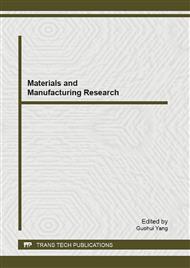[1]
C L Hwang, K Yoon. Multiple Attribute Decision Making [M]. Berlin: Spring-Verlag, (1981).
Google Scholar
[2]
D F Li. Two New Methods for Multi-attribute Decision Makings with Information Partially Known [J]. Journal of Systems Science and Systems Engineering, 1998, 17(1): 70-74.
Google Scholar
[3]
J R Shi, S Y Liu, W T Xiong. A Method of Ranking Alternatives in Multiple Attribute Decision Making [J]. Systems Engineering, 2004, 22 (7): 99-107.
Google Scholar
[4]
J Q Wang. Study on hierarchical discrimination approach of multi-criteria classification with incomplete information [J]. Control and decision, 2004, 19(11): 1237-1240.
Google Scholar
[5]
Z C Yu, T H You,R Zhang etc. A Multiple Criteria Decision Making Method Based on Incomplete Weight Information [J]. Systems Engineering theory methodology applications, 2005, 14(6): 506-508.
Google Scholar
[6]
J Q Wang, B He. Method for multi-criteria decision with indefinite information based on evidential reasoning and its application [J]. Systems Engineering and Electronics, 2005, 27(4): 383-387.
Google Scholar
[7]
H A Zhou,S Y Liu. Approach to Multi-attribute Decision-making and Theoretic Proof of Its Solution Based on Two-phase Optimizations [J]. Systems Engineering and Electronics, 2005, 27(8): 1425-1427.
Google Scholar
[8]
G X Song, D L Yang. Combination weighting approach based on the decision-maker's preference and consistency of weighting methods [J]. Systems Engineering and Electronics, 2004, 26(9): 1227- 1290.
Google Scholar
[9]
H Y Chen. Combination determining weights method for multiple attribute decision making based on maximizing deviation [J]. Systems Engineering and Electronics, 2004, 26 (2): 194-197.
Google Scholar
[10]
S L Yan, X P Xiao. Integrated Approach Based on Minimum Deviation Model for Mul ti-attribute Decision Making [J]. Systems Engineering.
Google Scholar
[11]
Z P Fan, J Ma, Q Zhang. An approach to multiple attribute decision making based on fuzzy preference information [J]. Fuzzy Sets and Systems, 2002, 131: 101-106.
DOI: 10.1016/s0165-0114(01)00258-5
Google Scholar
[12]
Z S Xu,. A Method for Multi-attribute Decision Making without Weight Information but with Preference Information on Alternatives [J]. Systems Engineering—Theory and Practice (in Chinese), 2003, 23(12): 100-103.
Google Scholar
[13]
J Ma, Z P Fan , L H Huang. A subjective and objective integrated approach to determine attribute weights[J]. European Journal of Operational Research, 1999, 112: 397-404.
DOI: 10.1016/s0377-2217(98)00141-6
Google Scholar
[14]
J Wu, C Y Liang, W H Li. Method to determine attribute weights based on subjective and objective integrated [J]. Systems Engineering and Electronics, 2007, 29(3): 383- 387.
Google Scholar
[15]
Z S Xu. Method for multi-attribute decision making with preference information on alternatives under partial weight information. [J]. Control and decision, 2004, 19(1): 85-88.
Google Scholar
[16]
W T Xiong, S Y Liu, W H Li. A Method to Determine Multi-attribute Weights Based on Sensitivity Analysis [J]. Journal of Wuhan University of Technology, 2004, 26(12): 92-95.
Google Scholar


